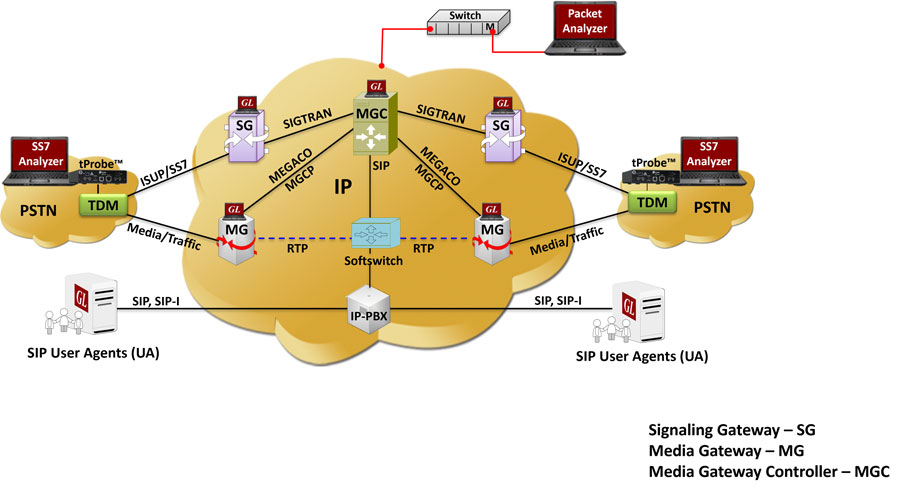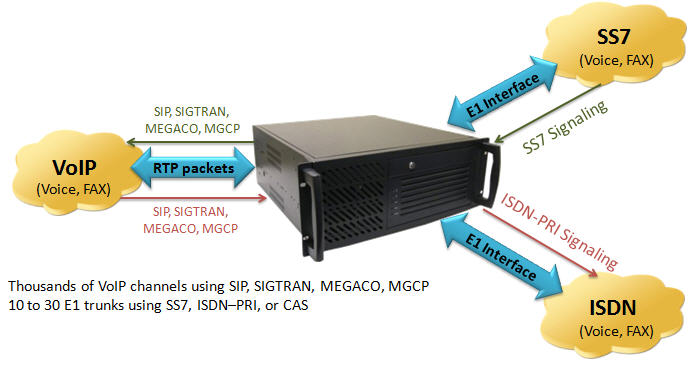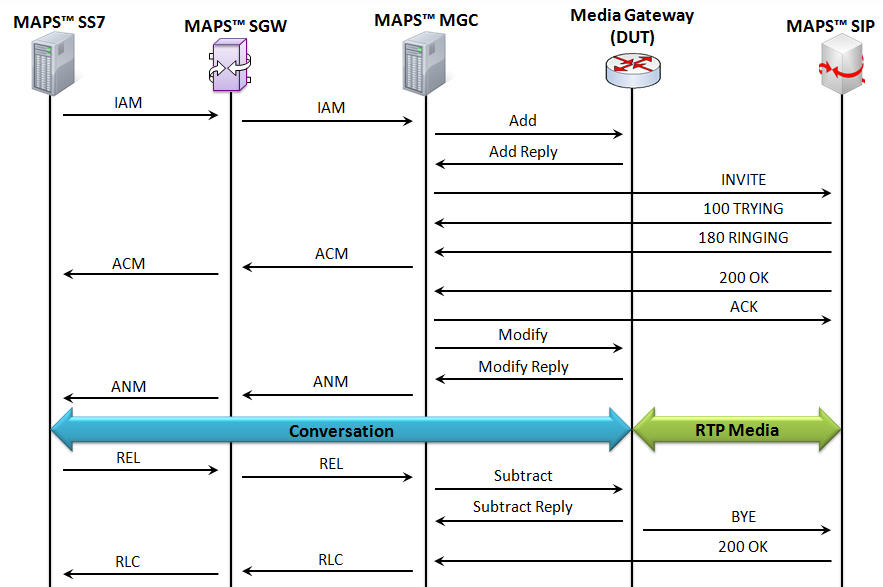GL Announces Products for Testing / Emulation Of Media and Signaling Gateways
Welcome to a June 2014 issue of GL's Newsletter providing information and insight into our products that provide testing and emulation of Media and Signaling Gateways and Media Gateway Controllers.
Carriers and enterprises are migrating to IP Networks from traditional PSTN Networks because IP Networks provide substantial advantages - such as voice, data, and video convergence, greater platform densities, rapid service and feature enhancements, and productivity gains from unified communications. However, the transition to all IP requires "Gateways" that convert legacy signaling and traffic carried over TDM to new IP signaling / traffic carried over IP/Ethernet - therefore the need to test and emulate elements within both.

An Example of a TDM IP Hybrid Network
Test and Verification of TDM / VoIP Network Elements Using MAPS™
GL's MAPS™ (Message Automation and Protocol Simulation) platforms can be used to simulate various elements in a hybrid TDM VoIP network. A typical depiction of a hybrid TDM/IP network is shown above. SS7 signaling in the PSTN is translated to SIGTRAN by the Signaling Gateway (SG). TDM traffic is repackaged into RTP packets by the Media Gateway (MG). A Media Gateway Controller (MGC) controls the various elements within the IP Network using SIP, Megaco, and MGCP protocols. The reverse may happen if the call is destined to PSTN. If the call stays within the IP domain, then an IP PBX may route the call to an IP endpoint.
A typical MAPS™ platform simulating a Signaling Gateway may consist of high density T1 E1 Cards, a Gigabit Ethernet Card, a multiprocessor CPU (such as an i7 PC) and MAPS™ SIGTRAN and MAPS™ SS7 software. Pre-written scripts translate SS7 to Sigtran and vice a versa. Media Gateways can be similarly integrated using MAPS™ software products, for Media Gateways high density T1 E1 Cards and MAPS™ Megaco or MAPS™ MGCP is required. Similarly, MAPS™ can assume the role of any of the elements.

Gateway between VoIP and Legacy PSTN
- TDM Call Generation (SS7, ISDN, CAS) - Hundreds to thousands of calls can be generated by MAPS™ SS7, MAPS™ ISDN, or MAPS™ CAS elements.This includes TDM traffic such as voice and fax over T1 E1 and ISUP signaling per ITU-T, ANSI, ETSI and CHINA standards. ISDN and CAS are also supported.
- SS7 to SIGTRAN Gateway Emulation - MAPS™ SIGTRAN and MAPS™ SS7 can be combined into one entity to emulate a complete Signaling Gateway. M3UA, M2UA, and M2PA modes are easily supported.
- Media Gateway Emulation - MAPS™ MEGACO or MAPS™ MGCP can be configured with T1 E1 trunks to simulate a Trunking Media Gateway. Megaco signaling to/from a Media Gateway Controller is used to establish TDM to RTP connections and vice versa. Codec support is provided for common G.711 ULAW, G.711 ALAW, G.729, G.729B and many more. Fax is also supported.
- Media Gateway Controller Emulation - MAPS™ MEGACO, MAPS™ SIP, MAPS™ MGCP, and MAPS™ SIGTRAN can be combined to perform Media Gateway Controller functions - interacting with multiple Media Gateways and multiple Signaling Gateways and as a SIP server as well. Scripts can be written to route calls to different Service Switching Point's and SIP users based on area codes.
- Signaling and Traffic Analysis - PacketScan™ - an All-IP Analyzer can be configured on a remote system for capturing all signaling - SIGTRAN, MEGACO, SIP and RTP Traffic in real-time.
- Signaling and Traffic Analysis - An SS7 Analyzer can be configured on a remote system for capturing all SS7 signaling and bearer traffic.
TDM-to-IP Simulation
A typical use of MAPS™ platforms to test a Media Gateway is shown in the ladder diagram below. Here, MAPS™ platforms are used to simulate all the elements surrounding the Media Gateway (DUT). MAPS™ SS7 is used to generate bearer traffic and SS7 signaling, MAPS™ SGW converts SS7 signaling to SIGTRAN, MAPS™ MGC acts as Media Gateway Controller, and finally MAPS™ SIP as an IP Endpoint.
- SS7 Call Simulator sends signaling traffic out SS7 link to SG Simulator
- SG converts SS7 signaling to SIGTRAN and sends it to MGC Simulator
- MGC Simulator sets up bearer channel in real MG over Megaco
- Once bearer channel is established, MGC Simulator directs bearer traffic to Softswitch SIP user over RTP
- Softswitch SIP user sends bearer traffic back to SS7 Call Simulator to simulate voice call

 Back to Newsletter Index Page
Back to Newsletter Index Page